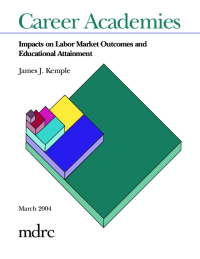Career Academies: Impacts on Work and Educational Attainment
Updated findings are available in Career Academies: Long-Term Impacts on Labor Market Outcomes, Educational Attainment, and Transitions to Adulthood (2008).
Established more than 30 years ago, Career Academies have become a widely used high school reform initiative that aims to keep students engaged in school and prepare them for successful transitions to post-secondary education and employment. Typically serving between 150 and 200 high school students from grade 9 or 10 through grade 12, Career Academies are organized as small learning communities, combine academic and technical curricula around a career theme, and establish partnerships with local employers to provide work-based learning opportunities. There are estimated to be more than 2,500 Career Academies across the country.
Since 1993, MDRC has been conducting a uniquely rigorous evaluation of the Career Academy approach that uses a random assignment research design in a diverse group of nine high schools across the United States. Located in medium- and large-sized school districts, the schools confront many of the educational challenges found in low-income urban settings. The participating Career Academies were able to implement and sustain the core features of the approach, and they served a cross-section of the student populations in their host schools. This report describes how Career Academies influenced students’ capacity to improve their labor market prospects and sustain their engagement in post-secondary education programs in the four years following their expected graduation. The results are based on the experiences of more than 1,400 young people, approximately 85 percent of whom are Hispanic or African-American.
Key Findings
- The Career Academies substantially improved the labor market prospects of young men, a group that has experienced a severe decline in real earnings in recent years. Through a combination of increased wages, hours worked, and employment stability, the young men in the Academy group earned over $10,000 (18 percent) more than those in the non-Academy control group over the four-year follow-up period.
- The Career Academies had no significant impacts (positive or negative) on the labor market outcomes for young women. This may be due, in part, to the fact that young women in both the Academy and the non-Academy group had greater propensity than the young men to be attending school or taking care of children.
- Overall, the Career Academies served as viable pathways to a range of post-secondary education opportunities, but they do not appear to have been more effective than options available to the non-Academy group. More than 90 percent of the students in the Academy and non-Academy groups graduated from high school or received a General Educational Development (GED) certificate. By the end of the follow-up period, more than half the sample had completed a post-secondary credential or were working toward one.
- The positive labor market impacts were concentrated among Academy group members who were at high or medium risk of dropping out of high school when they entered the programs. Although the Career Academies reduced enrollments in post-secondary education among those who entered the programs at highest risk of dropping out, this does not appear to have diminished the substantial earnings advantage produced by the Academies for this subgroup. The lack of labor market impacts for the low-risk subgroup may be due to this group’s greater focus, relative to the others, on post-secondary education.
The findings demonstrate the feasibility of improving labor market preparation and successful school-to-work transitions without compromising academic goals and preparation for college. They provide compelling evidence that investments in career-related experiences during high school can produce substantial and sustained improvements in the labor market prospects of youth during their post-secondary years. In fact, Career Academies are one of the few youth-focused interventions that have been found to improve the labor market prospects of young men.







